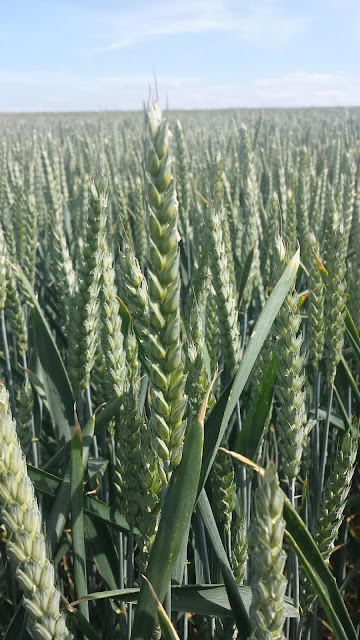Straw incorporated seedbed has a wonderful odour. an organic soap full if biological activity. Osr plants just chitting but slugs will have to snuff them out amidst other soil smells.
Biologically inert soils are a slug magnet to seed germination.
Tuesday, 15 September 2015
Yummy soils
Monday, 7 September 2015
Wednesday, 24 June 2015
Wednesday, 17 June 2015
Good ears but poor drilling
Yield us ear number per m2 X grains per ear X wt per grain.
In this field we have good spiklet number o'er ear but not enough ears per m2.
Due to poor establishment at drilling.
Very hard to redress...
Tuesday, 16 June 2015
Critical time for grain fill
If we've got it here in good shape we just need sun - water to see us through.. If we lose the water the plant will need to use its water soluble carbohydrate stores. This is why we build them up at flag leaf with a quality bio-stimulant. Cuts down on ear aphid attacks as well due to sugar concentrations. (High Brix).
Monster ears
Wheat varieties and location differences. Cereals 2015 in Lincolnshire averaged 16 spiklets. Revelation in Somerset averaging 22. Very large ears. But crop starting to show stress defence symptoms. .. We need the water or access to stored up WSC's for grain fill.
Tuesday, 26 May 2015
Cover crop in fodder beet.
Spring barley cover crop to protect seedlings and soil from wind blow and soil movement. To be removed once plants established. But adding to soil biomass and exudate feeding soil biology.
Wednesday, 8 April 2015
Wednesday, 25 March 2015
Successful black grass control
The best time to really get on top of black grass is in the Oilseed rape crop rotation. Followed by good soil & seedbed management of the next crop.
CO2 reduction by min till following an osr crop where control has been poor, is fatal.
Good soil CO2 release creates good germination of all seeds allowing us to get control. Reducing C02 reduces germination of black grass seeds and crop.
Soil management is key.
Friday, 13 February 2015
Forward barley grazed off
A very early crop of winter barley grazed off by sheep has come on well. The removal if lush leaf has removed disease and choking canopy. .
Tuesday, 10 February 2015
Mesocotyl
Deep drilling requiring the production of new roots .. not here yet. We need a bit more warmth and stimulus.
Monday, 9 February 2015
Early Feb wheat
Backward wheat requiring some early n to get it moving.
Root and tiller production dependant on early energy and rooting.
Feed the roots.
Tuesday, 27 January 2015
Backward osr
Rape sitting in cold wet soils is suffering a little. Pigeons are having a little feed, we will be making GAI assessments in early Feb and think about early fertiliser to get it going along with stimulating root exudate.
A forward piece of raoe
Wow what a root.. Just what we want to be the foundation for production.
Some of these plants are too far forward and will need some regulation.
Phosphate shortage
Recent cold wet weather gas brought on symptoms of nutrient deficiency.
Phosphate and magnesium along with manganese. See next blog.
Manganese deficiency
Treated seed has held out very well this year with high brix readings. But the recent colder weather has changed the redox potential of the soil and we are now seeing the first signs of manganese deficiency in the crop.
Application required with some urgency. Don't forget to include humates.





















